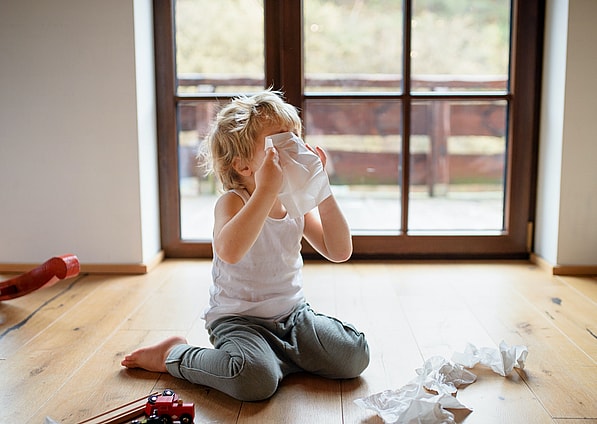
Are you tired of constantly wiping your child’s runny nose? It can be frustrating when your little one has the sniffles and doesn’t know how to blow their nose effectively.
In this post, we’ll look at helpful hints and enjoyable methods to educate your child on how to blow their nose, so you can say goodbye to those endless tissues and hello to a more comfortable and confident youngster.
Tips on how to teach a child to blow their nose
Blowing your nose is an important life skill that your child will need to learn to clear their nose for breathing, prevent germs, and stay healthy, but it may be difficult to comprehend. Thankfully, when you teach a child to blow their nose, it can be an involved experience as a parent and even more enjoyable than you’d think.
1. Teach them the concept of blowing your nose

When you begin to teach a child to blow their nose, it helps to explain the notion of blowing air through their nose. Sometimes, it makes sense to compare it to snorting, a noise that young children might know by now, so they can feel what you mean. It’s helpful to explain to your youngster that blowing their nose removes mucus and debris from their nasal passages, which will actually make them feel better. Show them how you do it and then have them try.
Check Out: Beginners Guide to Parenting: Top 10 Tips from New Moms
2. Make it an enjoyable exercise
Kids don’t usually want to blow their nose because it feels weird to them, so making it a fun and engaging activity might help them participate in and learn the habit more efficiently. You may use a tissue or a soft cloth as a prop and urge your kid to blow on it like a trumpet. You may also play “who can blow the longest” and “who can blow the harder” games to get them in the spirit.
3. Experiment with bubbles

Water is another good approach to educating a youngster to blow their nose. You may generate bubbles with a straw and a bowl of water by encouraging your youngster to blow air through the straw. Old-fashioned bubbles can work to demonstrate how the air comes out of their nose also. This can help children learn how to regulate airflow out of their noses and create the muscle memory needed to efficiently blow their noses.
4. Show the proper technique
Demonstrating the appropriate technique while training a youngster to blow their nose is critical. Instruct your kid to put the tissue or cloth over their nose and mouth, then blow air out of one nostril while closing the other. To avoid discomfort or irritation, they should blow lightly and gradually.
Also Read: What Is a Nanny Share and How Can It Help Your Family?
5. Make it a habit
Creating a schedule for blowing their nose might help your kid acquire the habit of blowing their nose regularly. This is great, especially if they have allergies or get colds frequently. Make it a part of your child’s everyday routine, such as before meals, after playing, and before bed. This will teach your child the necessity of blowing their nose and include it in their regular hygiene regimen.
Furthermore, make tissues readily available and accessible for your child so that they may quickly blow their nose as necessary.
6. Use positive reinforcement
Like any new ability, practice is essential in learning how to blow their nose. Urge your kid to wipe their nose frequently throughout the day, especially if they have a stuffy or runny nose. Be patient and provide positive feedback whenever your child shows improvement, no matter how small.
To keep kids motivated, make it fun by playing games or using props and congratulate their triumphs. Your youngster will become more comfortable with the technique and be able to blow their nose successfully.
Fun ways to teach a child to blow their nose

With a little imagination and perseverance, you can make the process painless for you and your child. Here are some creative and entertaining methods that can teach a child to blow their nose.
- Playing the straw game: Give your child a little straw and instruct them to blow a cotton ball or a small piece of paper across a table with it. This might help children practice controlling how much air they blow out of their noses.
- Blowing feathers: Put a feather in front of your child and ask them to blow it across the table using their nose. This may be a fun and simple technique for youngsters to learn how to blow air out of their noses and regulate airflow.
- Blowing tissue paper: Give your child a piece of tissue paper and encourage them to hold it over their nose while softly blowing air out of it. They can also blow harder or gentler to shift the tissue paper.
- Making a Windmill: A sheet of paper and a straw can be used to build a simple windmill. Teach your toddler how to spin the windmill by blowing air through the straw. This may be an entertaining and participatory technique for them to practice blowing air out of their nose.
Check Out: 6 Ways to Motivate Your Kids to Help with the Housework
Why can it be difficult for children to blow their noses?
Blowing your nose may appear to be a simple to us adults, but it can be difficult for young children to grasp. Children may have difficulty blowing their nostrils for a variety of reasons.
First of all, they aren’t used to the action or the feeling. It can be an unpleasant experience for youngsters who are not accustomed to the sensation of air going through their nostrils. Also, they may lack the muscular control to manage airflow through their nasal passages. Young toddlers may not grasp the instructions right away and may not realize their nose is running.
As a result, being patient and compassionate with your child while they learn to blow their nose is essential. They will ultimately get the hang of it with practice and effort, and you will both be able to live a healthier and more pleasant life together.
At what age should a child be able to blow their nose?
While there is never an exact science to child milestones, it is proven that children can learn to blow their nose around age 2. However, not every child will get it that young. The age range provided is between 2-7, so this is when to start instilling those habits and teaching them about hygiene. They will also learn more about blowing their nose once they are in daycare or school because other children will probably start doing it as well.
Also Read: How to Get a Passport for a Child When One Parent Is Absent
Takeaway
It may take some time and patience to teach your child to blow their nose, but with a little ingenuity and some engaging activities, it can be a gratifying experience. Using amusing methods can help you teach a child to blow their nose in a less daunting environment. Remember to compliment your child on their efforts and encourage them to continue practicing.
You may also want to keep assisting them in the beginning, so that they have support and guidance until they become more independent. Once your child learns to blow their nose, they will be able to relieve some of their illness symptoms and you’ll both be happier.
